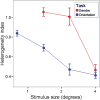Spatial heterogeneity in the perception of face and form attributes
- PMID: 21109440
- PMCID: PMC5056559
- DOI: 10.1016/j.cub.2010.11.017
Spatial heterogeneity in the perception of face and form attributes
Abstract
The identity of an object is a fixed property, independent of where it appears, and an effective visual system should capture this invariance [1-3]. However, we now report that the perceived gender of a face is strongly biased toward male or female at different locations in the visual field. The spatial pattern of these biases was distinctive and stable for each individual. Identical neutral faces looked different when they were presented simultaneously at locations maximally biased to opposite genders. A similar effect was observed for perceived age of faces. We measured the magnitude of this perceptual heterogeneity for four other visual judgments: perceived aspect ratio, orientation discrimination, spatial-frequency discrimination, and color discrimination. The effect was sizeable for the aspect ratio task but substantially smaller for the other three tasks. We also evaluated perceptual heterogeneity for facial gender and orientation tasks at different spatial scales. Strong heterogeneity was observed even for the orientation task when tested at small scales. We suggest that perceptual heterogeneity is a general property of visual perception and results from undersampling of the visual signal at spatial scales that are small relative to the size of the receptive fields associated with each visual attribute.
Copyright © 2010 Elsevier Ltd. All rights reserved.
Figures



References
-
- Biederman I, Cooper EE. Evidence for complete translational and reflectional invariance in visual object priming. Perception. 1991;20:585–593. - PubMed
-
- DiCarlo JJ, Cox DD. Untangling invariant object recognition. Trends Cogn Sci (Regul Ed) 2007;11:333–341. - PubMed
-
- Gross CG, Rocha-Miranda CE, Bender DB. Visual properties of neurons in inferotemporal cortex of the Macaque. J Neurophysiol. 1972;35:96–111. - PubMed
-
- Burton AM, Bruce V, Dench N. What’s the difference between men and women? Evidence from facial measurement Perception. 1993;22:153–176. - PubMed
Publication types
MeSH terms
Grants and funding
LinkOut - more resources
Full Text Sources

